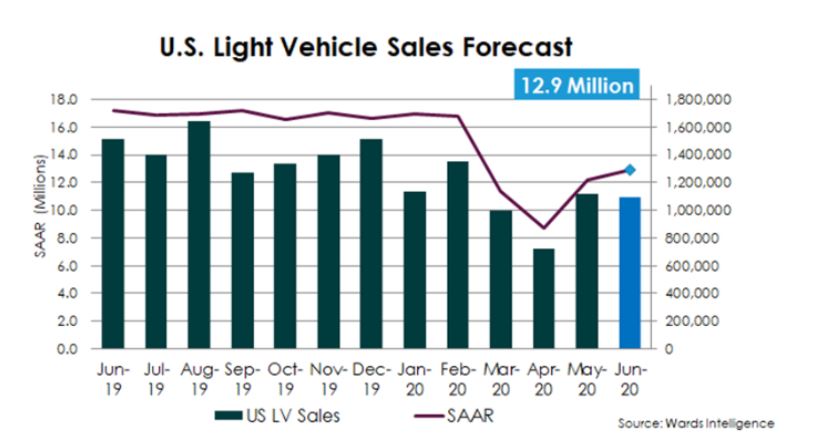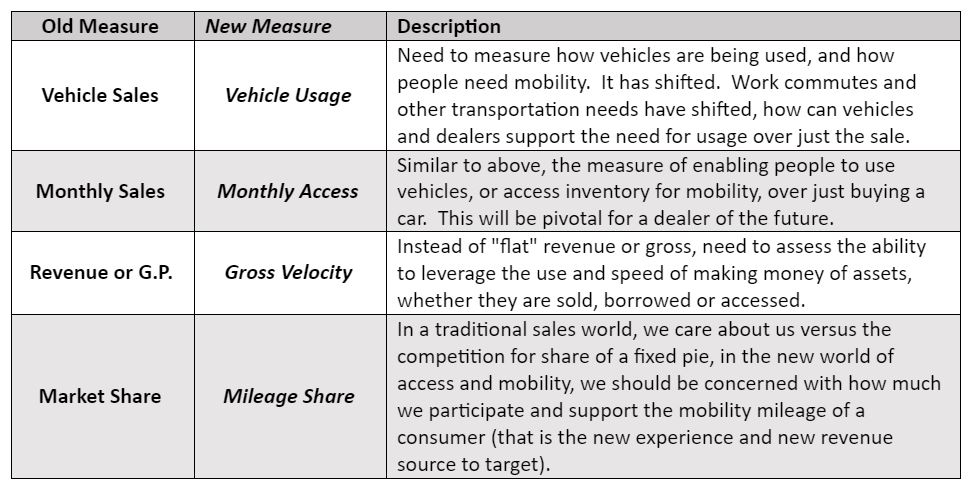This Is How Automotive Retail is Transforming

In the earliest of days, weeks, and even months for auto dealerships returning to business (open doors at the facility), we are getting some encouraging early indications of leads being a decent volume, retail sales bouncing back a bit, and revenue and profit returning to levels of operational survival. At least that seems to be the narrative. Inventory depending on the brand and model can be challenging, but nonetheless, a fairly good bounce back from the days of March through May, by most indications.
As being reported by Ward's and others, June auto sales will defy bragging about compared to year-over-year and by expected standards, but at least they're on an upward trend. July retail deliveries aren't expected to set off firecrackers either, and fleet sales with the rental agency bankruptcy and economic woes deflate total volume as well.
On a yearly forecasted perspective, there is some upwardly hope as well. Wards Intelligence expects June's seasonally adjusted annual rate to total 12.9 million units (See chart below). That compares with May's 12.2 million and April's awful 8.7 million.
Moreover, it is well below June 2019's 17.2 million-unit SAAR and the 16.8 million deliveries that were predicted, pre-pandemic, for 2020.
Yes, unemployment and production start-up and interruptions, consumer confidence, the pandemic, and fears of normalcy all weigh in on this. But are we looking at the right figures and metrics to see what is really happening? Are we even evaluating the right measures? I would also argue that we will have to shift, and in fact, transform the very way in which we both "sell" cars and evaluate the industry as a whole.
While some indicators may not be entirely easy to quantify, there are new measures and KPI's that we must start considering, and in fact running our retail business by and guiding our new business practices and operations towards. Some examples of the new metrics that I believe will 1) drive survival through this crisis, and 2) transform your retail business into a next normal thriver, include:
Now I am not going to suggest we throw out the old standard measures, but in order to transform, in order to think differently, we must establish new targets and metrics. These new measures will keep us focused on what the needs of consumers are and will be and how we fulfill them.
In order to accomplish an auto retail industry and business transformation, I believe there are four major components (or capabilities) to consider:
1. Not vehicle sales, but vehicle usage

The industry analysts, OEMs, captives and banks, third party retail portals, and certainly dealers must all monitor shifts to measuring and supporting vehicle usage over vehicle sales. I won't go into a ton of detail why the world of vehicle sales, vehicle needs, and vehicle mobility has been disrupted forever, but I think most of us realize it has. What we knew as daily work and social commutes, weekend get-aways, road trips, and all of our life is under dramatic shift and unknown future. What will be constant is our need for mobility when we want, how we want, and where we want.
This provides both a challenge and an opportunity for auto retailers. How do I support the market for people to gain access or usage of a vehicle, and provide the product, the service, and/or the experience to do so and make it a profitable endeavor for my business? In fact, how may that actually become the guidepost for my business of the future? Dealers (and OEMs and financial institutions) will need to redefine what success looks like and how it can be profitable. It will have to include the idea and strategy and measurement of providing access to vehicles, and not just the transaction of vehicles. This may or may not include versions of providing fleet and rental, subscription or license options, car sharing and car riding, new flexible lease and mileage options, other vehicle and service options like electric charging, vehicle and fleet disinfecting, pick up and drop off (not just to the dealership but as a more mobile customer journey service), and much more that will be supportive of overall customer vehicle usage and customer mobility. That is the target for future success.
2. Focus on customer experience
The idea and practice of customer experience are certainly not new, but it did take on a magnified focus with the pandemic crisis shifting how many people interacted and expected any retail business to operate and accommodate. I even wrote about "experience" needs to be the North Star for an organization. It should be the ultimate goal, and the functional operations and capabilities need to be transformed and configured to deliver upon it. Customer experience and fulfilling customer expectations will be the very thing that defines the auto retail industry of the future as we work through this shifting landscape.
In auto retail, this is even more of an imperative. Consumers are now more than ever walking from one industry and one experience to the next, expecting a certain standard. We must follow the customer's lead. How can we serve them and empathize with their journey and daily life and intersect in a meaningful and valuable way? This absolutely means pick-up, drop-off, driveway delivery, "no touch" servicing, mobile service, omni-channel and preferred channel access, and support for their mobility needs. It will mean even more yet to be determined. The customers are telling us what they want and need. The key is, are we listening?
Be sure to listen. Apply your own experiences and expectations of other organizations and industries. Start by supporting customer empathy and customer experience, and you will find the revenue and opportunities from it. Customers will pay for better experiences.
3. Don't simply digitize current processes
This is a pitfall too many businesses and too many dealers fall into. If I just add technology, it will help, and things will get better. The technology is then either not adopted, does not work well with the current business operation, and overcomplicates and becomes cumbersome for the users. Digital change ultimately comes through People + Process + Technology. But process is first! Understand what the goals are, the North Star of customer and employee experience, and then make sure all processes are focused on delivering value to that end. If the process is not aimed at value for the customer or employee experience, it is simply adding unproductive and unsatisfactory work and noise.
A lot of current dealership processes need to change. It is great we have added more online selling and scheduling tools. But the workflows and processes need to support an efficient value-add process. There is no reason after conducting a majority of a sales process online that a customer should have to be at a dealership for, on average 3.5 hours to finish paperwork and take delivery. There is just not! It is the number one dissatisfaction with the car buying process and is just one of many that need to change. I can buy and sign for a house in less time.
Before any technology is ever implemented or added, make sure to consider and re-design the processes it will support. It is your opportunity for transformation. It is the best chance to advance and leapfrog ahead of a current state.
4. Become flexible, agile, transformative
Inherent in all of the above components and capabilities is the core principle to be agile and flexible. What does that mean? It means don't do business as usual. It means you may have to get uncomfortable. It means you may have to pivot and shift from a plan or previous strategy based on results and feedback and customer interest.
Your transformation strategy and plan should be a living guidepost. One that can be altered and changed to adapt to conditions and opportunities. To be agile, flexible and transformative is an actual capability; and probably the most valuable one. It will allow you to not get stuck chasing decaying margins or performing tasks that are not valuable.
A lot of insight and direction will come from your data, the old and new measures suggested your customers and a general sense of the business opportunities. Listen for it! Be agile, flexible, and humble enough to follow it.
This is not an overnight challenge or change. What I am suggesting is that life as we know it has changed. How we interact with retail has changed. How we use our vehicles or need mobility has changed. All has changed at least for quite a while, and some like the raised customer expectations have changed forever. So, let's understand those factors before we simply try to optimize some already archaic retail processes.
We must measure factors that are the real evaluation of what is happening with mobility, vehicle usage and access as well as customer mobility expectations. Those measurements are where we need to drive our future business to operate and perform. Those will indicate new capabilities an auto retailer must develop to keep evolving and transforming to a future state of what's next and what's successful.
Start with a North Star guide of what you want to deliver as an experience to customers and to employees. From there, create a plan and roadmap to build towards the capabilities necessary to deliver upon it; the people, process and technology. But always be agile, adaptive and flexible. Listen, pivot as needed, and pursue the customer experience. That will lead auto retailing through this crisis and into a new era of high value, high engagement and high satisfaction retailing experiences.
Tags:

authored by
Dennis Ephlin
Dennis is the Head of Automotive Industry, Innovation & Transformation at Capgemini Invent. An innovative strategist and transformer, Dennis’ experience includes driving brand and customer strategy into market and profit realization.
Dennis is a change artist who creates tangible business value through ideation and visioning, creative marketing strategies and process implementations, strategic business transformation and customer understanding and delivery.
Get Curated Insights
Content worth the click
Related Articles












